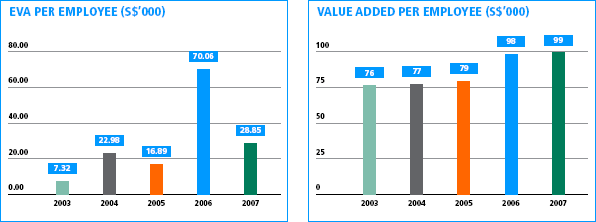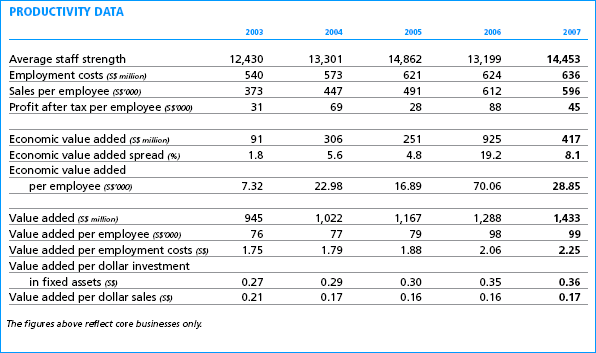 |
| |
 |
| |
In 2007, Sembcorp achieved a 6% growth in turnover to S$8.6 billion. Group profit after tax and minority interest (PATMI) before exceptional items (EI) in 2007 was S$557.2 million compared to S$380.8 million in 2006, which represents a growth of 46% over the previous year. Turnover from continuing operations increased by 15% to S$8.6 billion. PATMI before EI from continuing operations rose by 49% to S$557.2 million.
The Group recorded a net exceptional loss of S$31.0 million for 2007. This comprised the Group's share of losses recognised by the Marine & Offshore Engineering business relating to unauthorised foreign exchange transactions, which were partially offset by gains on the sale of certain investments. Sembcorp Marine announced that its wholly-owned subsidiary, Jurong Shipyard reached full and final settlement with nine of the 11 banks involved in the unauthorised foreign exchange transactions and the net position from the unauthorised foreign exchange transactions has now been reduced to US$258.7 million.
The Utilities and Marine & Offshore Engineering business units together contributed 96% of Group turnover in 2007.
Utilities' turnover increased by 9% to S$3.7 billion compared with 2006, despite its Singapore operations being impacted by plant shutdown during the year for major inspection. Utilities' growth in 2007 was also attributed to the continued good performance of its UK operations, which benefited from favourable power and steam prices.
Turnover for the Marine & Offshore Engineering business increased by 27% to S$4.5 billion. This was mainly due to strong performance by its rig building, ship repair, and offshore and conversion businesses.
The decrease in turnover for the Industrial Parks business was mainly attributable to the divestment of Nirwana Gardens and Wuxi Garden City Mall in May 2006 and May 2007 respectively. Vietnam Singapore Industrial Park was also deconsolidated with effect from April 2006.
Turnover of the Others/Corporate segment decreased by 42% to S$142.7 million due to the divestment of the Offshore Engineering business to Sembcorp Marine in 2006, partially offset by higher turnover from a subsidiary dealing in specialised construction activities as the subsidiary was consolidated only from June 2006.

The Group achieved a strong growth of 46% in PATMI before EI, fuelled by strong performance in Marine & Offshore Engineering business unit's rig building and ship repair businesses. Utilities, Environmental Management and Others/Corporate business units also performed well for the year.
The Utilities business' 2007 PATMI before EI was higher by 19% over 2006, primarily due to better contributions from its Singapore and UK operations. Utilities' operations in China recorded a profit in 2007 as compared to a small loss in 2006. Our cogeneration plant in Shanghai performed better than planned. Our Vietnam plant continued to do well during the period and our Middle East operations performed according to plan.
Sembcorp's share of PATMI before EI from its Marine & Offshore Engineering business unit grew in 2007, due to higher turnover and operating margins from the unit's rig building and ship repair businesses as well as better contribution from its associates.
PATMI before EI from the Environmental Management unit rose to S$13.6 million due to strong performance from its Australian operations. A writeback relating to a subsidiary amounting to S$4.3 million also contributed to the higher PATMI in 2007. The performance for 2006 was impacted by an impairment made for plant and equipment as well as a provision for contracts relating to the Singapore municipal waste collection sector.
The decline in Sembcorp's share of PATMI from its Industrial Parks business was mainly attributed to lower contribution from the industrial parks in Indonesia and China, which was partially offset by better contribution from the industrial parks in Vietnam. A write-back of provision on recovery of loan in 2006 also resulted in higher PATMI before EI recorded in 2006. The gain on disposal of Gallant Venture shares by the Industrial Parks business unit is reported under "Exceptional Items".
The increase in Others/Corporate PATMI in 2007 was mainly due to a write-back of S$48.0 million of tax provision made in prior years for the gains on divestment of an investment, following the favourable tax ruling by the Inland Revenue Authority of Singapore, partially offset by lower contributions from the offshore engineering business as part of the offshore engineering business was divested to Sembcorp Marine in 2006.


As at December 31, 2007, the Group had cash and cash equivalents of S$1.3 billion.
Net cash from operating activities was S$874.6 million for 2007 as compared to S$596.5 million for 2006, excluding the payment of S$260.6 million made to the banks for the unauthorised foreign exchange transactions in 2007 and payment for the Solitaire settlement of S$682.7 million in 2006. The strong operating cash flow was mainly contributed by our Singapore and UK Utilities operations as well as the Marine & Offshore Engineering business.
Net cash outflow from investing activities in 2007 was S$94.7 million. Proceeds from sale of subsidiaries, associates and other investments of S$441.6 million and dividends and interest received of S$98.2 million were partially offset by the spending of S$456.9 million on expansion and operational capital expenditure.
Net cash outflow from financing activities for 2007 of S$581.0 million relates mainly to dividends and interest paid.
Free cash flow, defined as operating cash flow plus investing cash flow adjusted for expansion capital expenditure, was S$991.9 million as at December 31, 2007.
Group shareholders' funds increased from S$2.8 billion at December 31, 2006 to S$3.0 billion at December 31, 2007. The increase was due to retained profits for the year and fair value adjustments for other financial assets partially offset by dividends paid to shareholders.
The increase in other financial assets was mainly due to the fair value adjustments for COSCO Corporation (S) (COSCO) shares held by Sembcorp Marine, which was partially offset by the sale of 39 million ordinary shares in COSCO.
"Inventories and work-in-progress" and "Trade and other payables" increased as more projects were undertaken by the Marine & Offshore Engineering business.
Excluding EI, return on equity increased from 18.3% in 2006 to 19.0% in 2007, and earnings per share increased to 31.3 cents in 2007 from 21.6 cents in 2006.
Subject to the approval by shareholders at the next annual general meeting, a final tax exempt one-tier dividend of 15.0 cents per ordinary share has been proposed for the financial year ended December 31, 2007.
Since 2003, we continue to generate a positive economic value added (EVA), achieving an amount of S$417.1 million in 2007. This positive EVA creation was mainly driven by better Group earnings.
Our net operating profit after tax (NOPAT) for 2007 amounted to S$730.5 million whilst capital charge increased to S$313.4 million mainly due to an increase in average EVA capital of S$339.4 million.
In 2007, the total value added by the Group was S$1.7 billion. This was absorbed by employees in wages, salaries and benefits of S$635.6 million, government in income and other taxes of S$185.7 million and providers of capital in interest and dividends of S$551.9 million, leaving the balance of S$346.2 million reinvested in business.





The financial statements are prepared in accordance with the Singapore Financial Reporting Standards (FRS).
With effect from January 1, 2007, the Group adopted the following new or amended FRS and Interpretations to FRS (INT FRS) which are relevant to the Group's operations:

The adoption of the above FRS and INT FRS did not result in substantial changes to the Group's accounting policies, except for the adoption of INT FRS 108 and INT FRS 112. FRS 107 and the complementary amended FRS 1 introduce new disclosures relating to financial instruments and capital respectively.
The change in accounting policy is applied retrospectively. The effects of adoption on the financial statements are as follows:

The following are two critical accounting policies that form the basis upon which the financial statements are prepared:
Revenue on goods sold is recognised when the significant risks and rewards of ownership have been transferred to the buyer. Revenue from repair work, engineering, overhaul, service work, and marine and civil construction contracts is recognised based on the percentage of completion method. The stage of completion is assessed by reference to surveys of work performed or by reference to the percentage of costs incurred to-date to the estimated total costs for each contract, with due consideration made to include only those costs that reflect work performed. Revenue on other service work is recognised when the work is completed. Revenue on sale of electricity and gases is billed and recognised upon delivery.
The recoverability or realisable value of the Group's assets is assessed in accordance with the various FRS. The carrying amounts of the Group's assets are reviewed at each balance sheet date to determine whether there is any indication of impairment. If any such indication exists, the assets' recoverable amounts are estimated. An impairment loss is recognised whenever the carrying amount of an asset or its cash-generating unit exceeds its recoverable amount.
Goodwill and intangible assets with indefinite useful lives are tested for impairment annually and as and when indicators of impairment occur. The rest of the significant accounting policies are set out in Note 2 in the Notes to the Financial Statements.
The Group's activities expose it to a variety of financial risks, including changes in interest rates, foreign exchange rates and commodity prices as well as credit risk.
Please refer to the Risk Management & Mitigation Strategies section of this report for details on the management of these risks.
In managing its interest rate and currency risks, the Group aims to reduce the impact of short-term fluctuations on the Group's earnings. Over the longer term, however, any prolonged adverse changes in foreign exchange and interest rates would have an impact on consolidated earnings.
Please refer to the sensitivity analysis as set out in Note 40 in the Notes to the Financial Statements.
Sembcorp consolidates and diversifies its sources of funding by building on existing bilateral banking relationships and developing new ones. The Group also accesses capital markets as and when appropriate. Available credit facilities amounted to S$4.8 billion (2006: S$4.9 billion), with unfunded facilities at S$1.9 billion (2006: S$2.3 billion).
Our focus is on maintaining an efficient and optimal mix of committed and uncommitted facilities and fixed and floating rate borrowings. The Group remains committed to balancing the cost of funding with prudent financial ratios. As at December 31, 2007, gross borrowings amounted to S$1.3 billion, of which 86% (2006: 87%) was committed funding. Of the overall debt portfolio, 64% (2006: 56%) constituted fixed rate debts which were not exposed to interest rate fluctuations.
The Group seeks to limit its interest rate exposure by adopting a prudent debt structure while balancing this with funding cost considerations. The weighted average cost of funding was lower at 3.85% (2006: 4.03%) and this was greatly assisted by a declining Singapore dollar interest rate environment in 2007. Interest cover ratio remained healthy at 15.3 times (2006: 22.4 times).
The current maturity profile of the Group's debt continues to favour the longer dated maturities, which reduces the impact of refinancing risk. As at end-2007, the portion of Group debt maturing beyond one year was 62%. At the same time, the debt structure allows for maximum flexibility to pay down short-term debts with available cash.
The Group's financing and treasury activities continue to be mainly centralised within Sembcorp Financial Services (SFS), the funding vehicle of the Group. SFS on-lends funds borrowed by it to companies within the Group. SFS also actively manages the cash within the Group by taking in surplus funds from those with excess cash and lending to those with funding requirements. Such proactive cash management continues to be an efficient and cost-effective way of financing the Group's requirements.
 |
|
|
|
| |
|